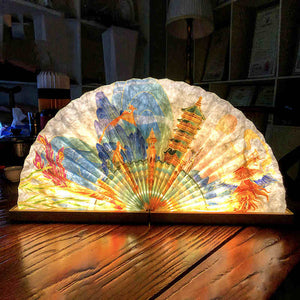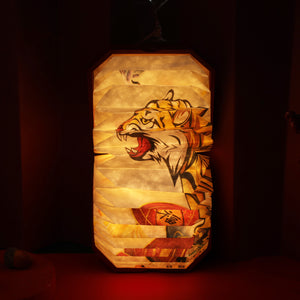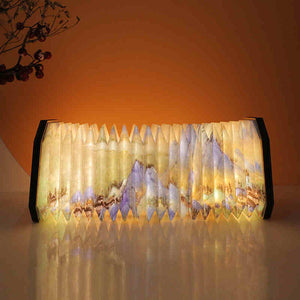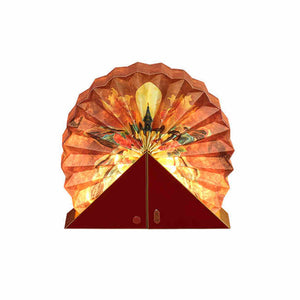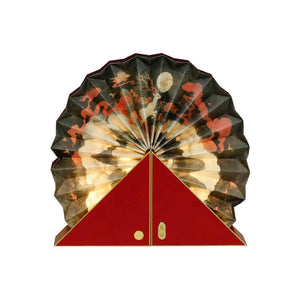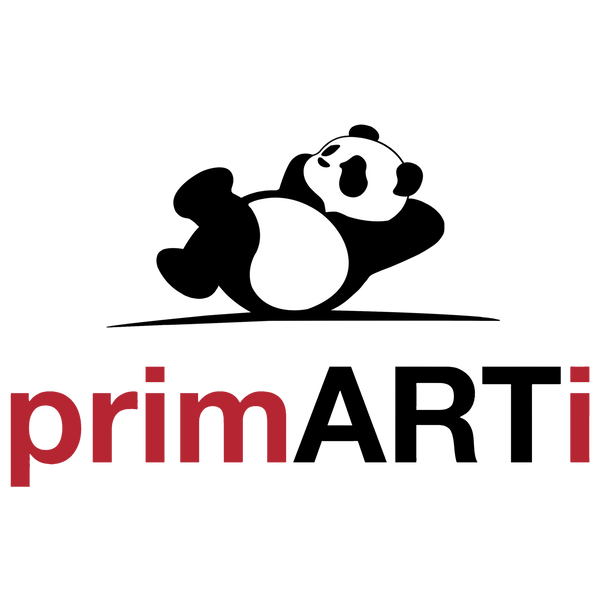One-Armed Paper-Cutting Artist Creates a World with Her Knife

Paper-cutting, also known as paper carving, is one of China's oldest folk arts with a history of thousands of years. With just a pair of scissors and a few sheets of red paper, folk paper-cutting artists can create works rich in meaning. In Pengshan District, Meishan, there is an artist who can create beautiful and exquisite patterns with only her left hand and a carving knife. Under her skillful hand, animals come to life and characters are vividly portrayed. She is Zeng Hua Rong, an outstanding inheritor of the paper-cutting craft.
Smiling in the Face of Life's Challenges
Born in August 1959 in Meishan's Chengguan Town, Zeng Hua Rong grew up in a family that many would envy. Her mother was a teacher, and her father worked at a cultural center. However, at the age of 1, an accident changed her life.
"At that time, both my parents were very busy working in Pengshan and had little time to take care of me," Zeng Hua Rong recalled. At around 1 year old, she was sent to live with her grandmother, who was also busy with work at a sugar and alcohol company, as were her two uncles with their machine repair jobs. One day, Zeng Hua Rong accidentally fell into a brazier and suffered severe burns, resulting in the disability of her right upper limb.
After the accident, Zeng Hua Rong returned to live with her parents. In order to be able to attend school like a normal child as soon as possible, Zeng Hua Rong began learning to write with her left hand at the age of 5, following her father, who was a fine arts officer at the cultural center. After two years of continuous daily practice, Zeng Hua Rong was finally able to enroll in elementary school.
However, at the age of 9, Zeng Hua Rong was sent to live with her grandmother again. "My parents felt that I was too dependent on them and that they did everything for me. Since my grandmother was busy and couldn't take care of me as meticulously, my parents wanted to cultivate my ability to live independently by sending me to her home," Zeng Hua Rong explained.
At her grandmother's house, Zeng Hua Rong learned to cook, wash clothes, and manage household chores with her left hand. Her parents' efforts paid off, as she was never deterred by life's challenges or academic pressures. "My classmates and friends were all very kind and often helped me. So, I always maintained a positive mindset," said the naturally optimistic Zeng Hua Rong, who never complained about her circumstances and faced life's difficulties with a smile. Despite having only one hand, she never let it hold her back.
A Passion for Paper-Cutting for 21 Years
After graduating from high school, Zeng Hua Rong started working at the Pengshan District Cultural Center in the library. During this period, under her father's guidance, she began to teach herself traditional Chinese painting and oil painting. This learning experience laid the foundation for her later choice of paper-cutting as an art form.
In 1997, after a job adjustment, Zeng Hua Rong began working with folk crafts. In order to quickly adapt to her new role, she decided to learn a traditional skill. Since painting with one hand was very inconvenient, she chose paper-cutting, which is closely related to painting, and also opted for a carving knife that she could better control with one hand as her tool. However, when her father learned of her decision, he did not support it.
"At that time, many people thought paper-cutting was not a high-class art form and was just for fun. My father also believed that while paper-cutting is easy to start with, mastering it is very difficult," Zeng Hua Rong said. Despite her father's disagreement, the strong-willed Zeng Hua Rong still persisted with her decision and began to delve into the art of paper-cutting. And she has been committed to it for 21 years.
Learning paper-cutting with one hand was already very challenging, and what's more, she had to teach herself. "There were not many people who could teach paper-cutting at that time, and with only one hand, it was hard for others to instruct me," Zeng Hua Rong said. In order to master paper-cutting, whenever she had free time, she would search for various materials in books and online to learn about the history and characteristics of paper-cutting. To create her own unique style, Zeng Hua Rong combined traditional Chinese painting with paper-cutting. Her works thus combined the boldness of northern Chinese paper-cutting with the delicacy of southern styles, giving them a strong artistic appeal.
Devoted to Carving Flowers "Blooming" on Paper
Holding an art knife and leaning over a sheet of red paper to carve is a common working mode for Zeng Hua Rong. When paper-cutting, she has to bend her head very low and channel the strength of her body into her left hand to slowly carve out the patterns. The entire process is slow but skillful.
"Paper-cutting may seem simple, but it actually involves many steps," Zeng Hua Rong said. Besides the final pasting, before carving, one also needs to conceive ideas, draw sketches, and make drafts, with each step requiring meticulous attention and no relaxation.
Although the traditional Chinese painting for the composition is complex, with her painting foundation and patient qualities, it takes a long time to complete a painting, but there is no problem in creating it. "Carving is probably the biggest difficulty I encountered in learning paper-cutting," Zeng Hua Rong said. Without the cooperation of the right hand, it is not only difficult to fix the paper during carving but also easy to wrinkle it. After long-term exploration and practice, Zeng Hua Rong replaced the thin wax paper with thicker and harder cardstock and changed her paper-cutting tool from a single-edged razor to a more suitable art knife.
Over the years, through continuous efforts, Zeng Hua Rong's paper-cutting skills have improved rapidly, and she has become a skilled paper-cutter at the cultural center. With one hand and a carving knife, she can silently and skillfully turn a sheet of red paper into blooming peonies, playful monkeys, and frolicking children.
Zeng Hua Rong told reporters that it usually takes a long time to complete a paper-cutting work, and if one cut goes wrong, all the hard work will be in vain. "For example, this piece 'Wealth and Honor,' with a peacock standing on a peony flower, took a lot of time to compose. Especially the carving of the peacock's feathers requires even more patience. If you make a mistake, the whole work will be ruined," she said.
In 2009, Zeng Hua Rong held her first personal paper-cutting art exhibition. "The exhibition was originally prepared for the 2008 Olympics, but it was delayed due to the earthquake. The theme of the works was sports." With lifelike figures and exquisite paper-cutting skills, Zeng Hua Rong's debut was a great success. It not only received affirmation from industry insiders but also attracted many schools to organize students to visit. The success of this exhibition greatly encouraged Zeng Hua Rong, and since then, her love for paper-cutting has grown even stronger, and she has worked harder to improve her skills.
To make her paper-cuttings more delicate and lifelike, she often observes petals, leaves, birds, and fish for long periods of time. To make the titles and inscriptions on her works more aesthetically pleasing, she, who has no calligraphy background, searches online for the most suitable fonts and practices carving them. Over the past 20 years, because of paper-cutting, Zeng Hua Rong has changed countless carving knives; her fingers have developed calluses; and her eyesight has deteriorated significantly. It is precisely because of her dedication and hard work that her works are more ingenious and have helped her stand out in various competitions. Her works have successively won the Excellence Award at the First Sichuan Provincial Disabled Persons' Arts Festival and have been awarded multiple times in municipal and county-level competitions. In 2013, Zeng Hua Rong was honored as an outstanding inheritor of Sichuan folk art (paper-cutting craft).
Volunteering to Teach Skills for Free
"The value of a paper-cutting work lies in its ability to convey the thoughts and emotions of the artist," Zeng Hua Rong once created a character paper-cutting titled "Intoxicated." In the picture, a little girl in a dress is looking up, picking grapes from a grapevine, and her basket is full of fresh grapes.
"Pengshan grapes are very famous. Every grape season, many tourists come to pick and enjoy them, completely intoxicated," Zeng Hua Rong introduced. As a local from Pengshan, she was very proud of this and immediately started creating a paper-cutting work that not only expressed her love for her hometown but also had a strong sense of life.
"A work without thought and emotion, no matter how exquisite the skill, can be seen through at a glance. The characters are not vivid and lack spirit," Zeng Hua Rong
